The LG G4 Review
by Joshua Ho on July 30, 2015 10:00 AM EST- Posted in
- Smartphones
- Qualcomm
- LG
- Mobile
- Snapdragon 808
- LG G4
System Performance Cont'd
While we’ve seen how the LG G4 performs in some general system workloads, in the interest of focusing a bit more strongly on GPU performance and gaming workloads we’ve also run a suite of benchmarks that are closer to mobile games in terms of workload and more strongly emphasize GPU performance. These tests are usually representative of burst/turbo performance. Those interested in steady-state performance can take a look at our extended rundown tests in the battery life section.
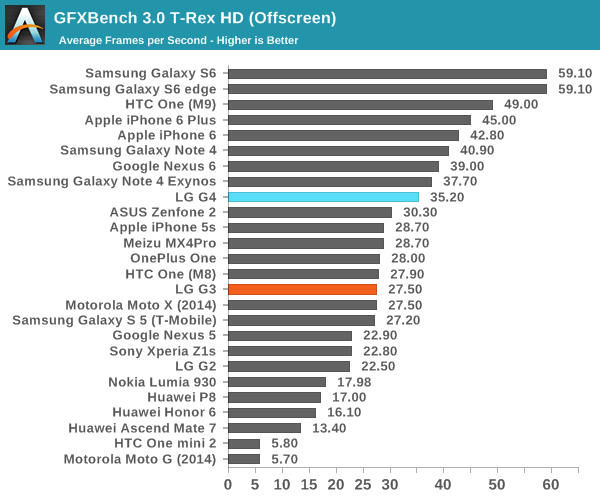
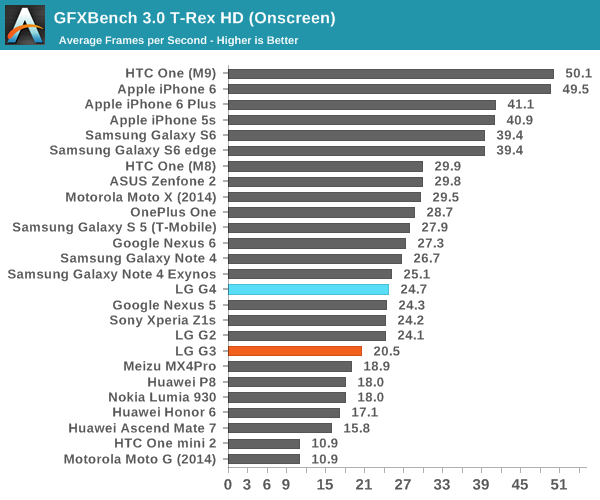
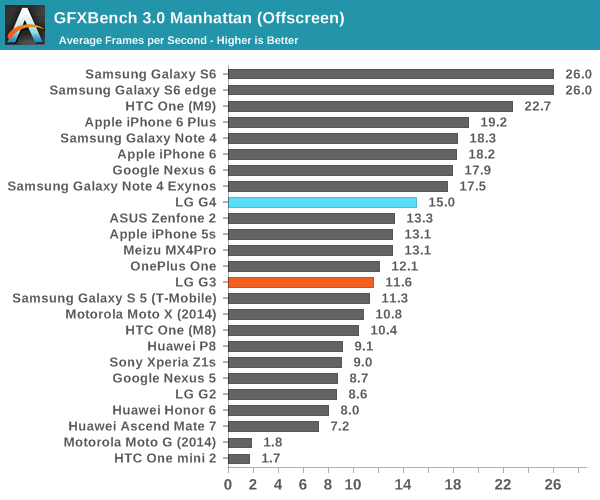
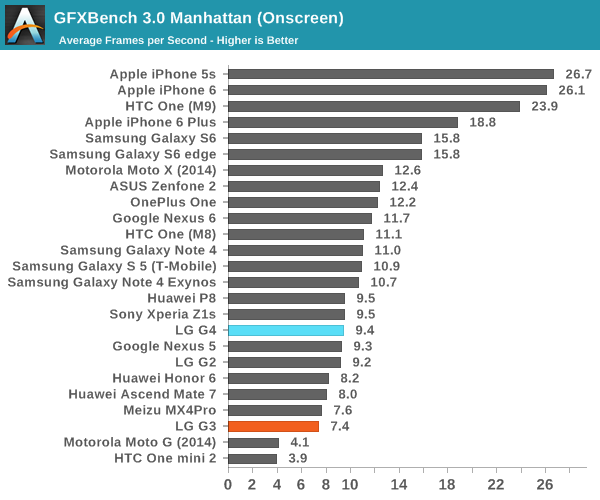
In GFXBench, we can see that the Adreno 418 GPU is a definite step up from the Adreno 330 in the Snapdragon 801, but not quite at the level of the Snapdragon 805's Adreno 420. As a result, on-screen performance is similar to the Snapdragon 800's Adreno 330. This seems to hold in both tests, which suggests that the balance between shader hardware and texturing hardware is relatively similar to the Adreno 330.
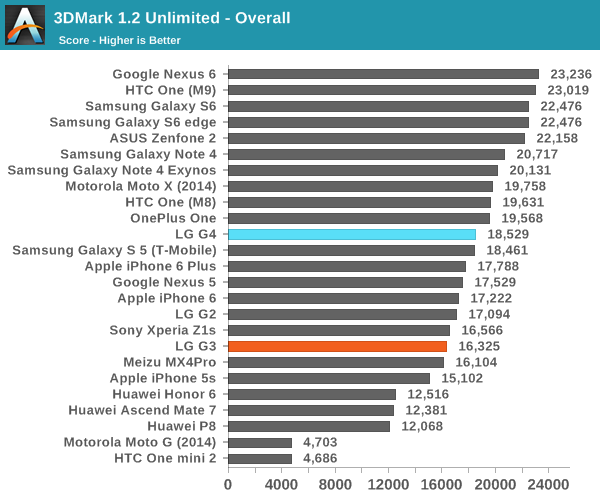
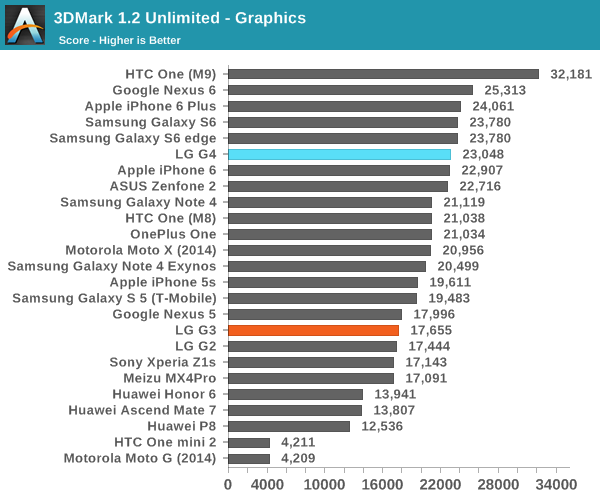
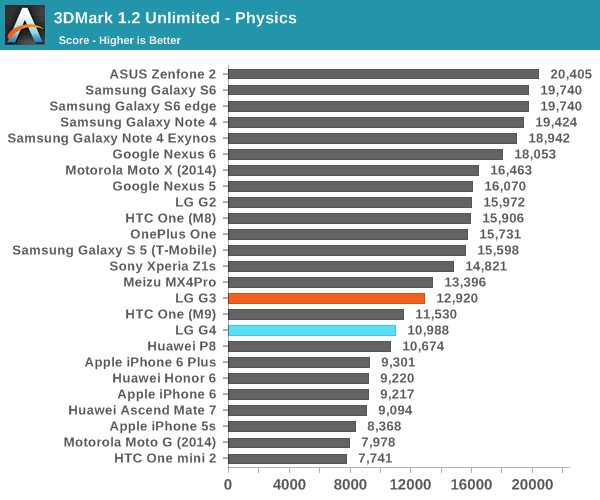
3DMark is a bit of an odd test in the sense that the factors that influence performance in the test are generally hard to predict, but we see a significant deficit in the physics test as it seems to be strongly influenced by main memory latency as the test is cache-unfriendly. The graphics test also indicates a minor improvement over the Snapdragon 801, likely due to differences in architecture from the Adreno 330 to 418 that are coming through in this test. At any rate, the end result is that the G4 ends up around the same level as Snapdragon 801 devices.
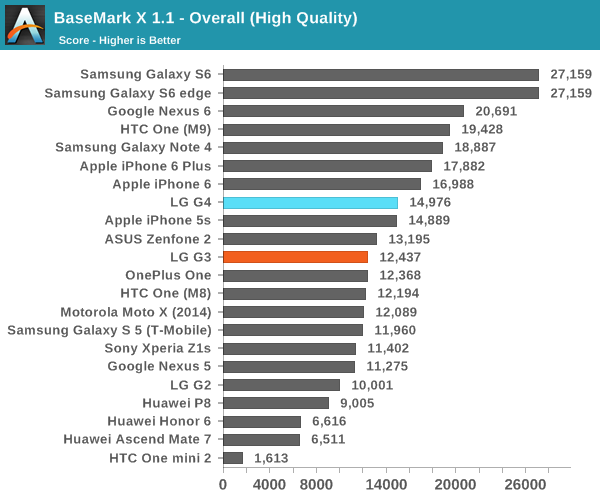
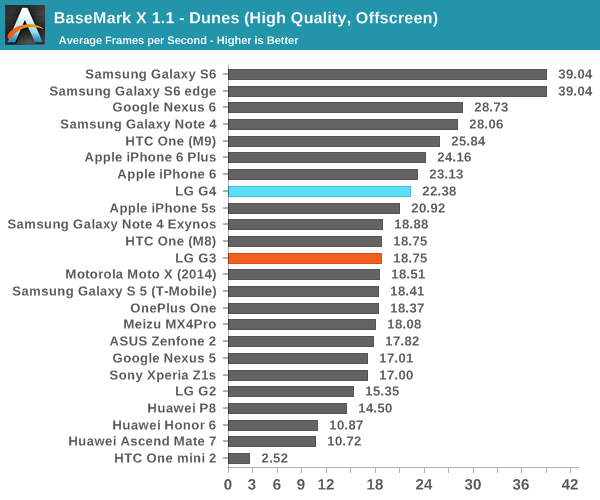
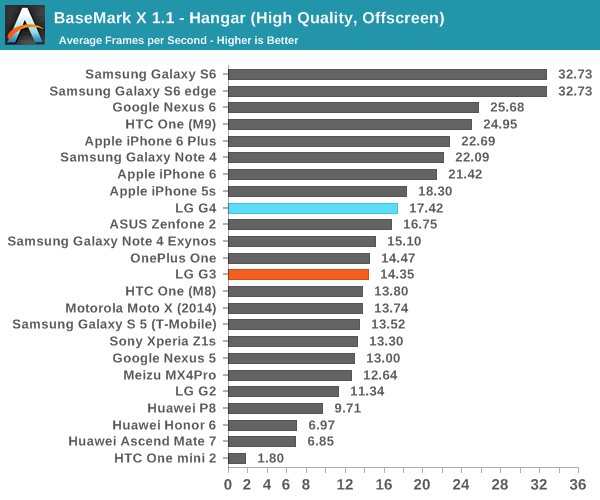

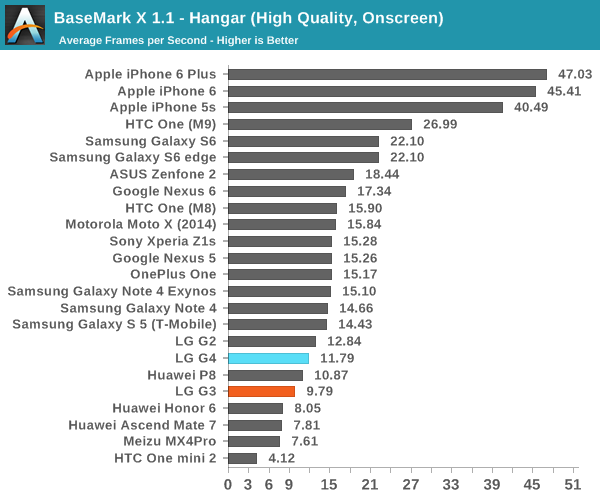
In this test we see that the G4 has a noticeable uplift relative to various Snapdragon 801 devices, but the improvement continues to be slim enough that in on-screen performance the 418 is really comparable to the Adreno 330 in the Snapdragon 800 rather than the Snapdragon 801, which puts it just below the Adreno 420. Overall, the LG G4 is definitely fast enough to enable a good user experience, although the somewhat weaker burst GPU performance leaves it at a handicap relative to anything equipped with an Exynos 7420. Given some of the issues we've seen with the Snapdragon 810, it seems that LG's choice was a wise one.
NAND Performance
Although NAND performance has always been important, until the Nexus 7 (2012) it wasn’t really an area that received a lot of scrutiny. For the most part, people didn’t really pay attention to storage beyond how much storage was available. As a result, this aspect of the device was often subject to aggressive cost control, often to the detriment of performance. However, in the case of the Nexus 7 we really started to see how cutting too far could make a device almost unusable instead of just slow and frustrating.
In the interest of testing this aspect of device performance, we use Androbench with some minor modifications to test settings to get a rough idea for how fast the internal storage solution is. In the case of the LG G4, it seems that Toshiba manufactures this NAND, named 032G74, but there’s otherwise not much information publicly available on this eMMC solution.
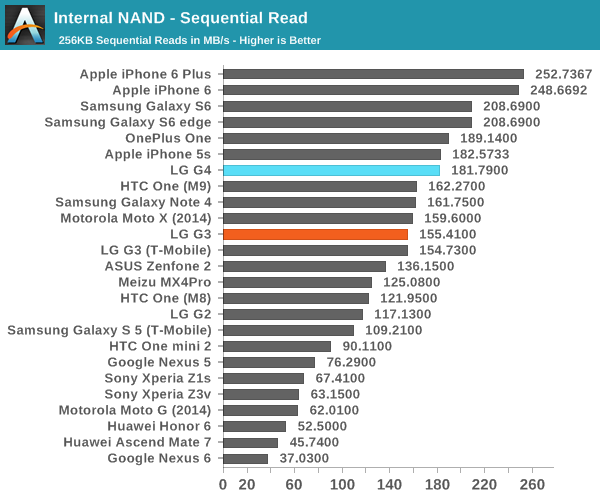
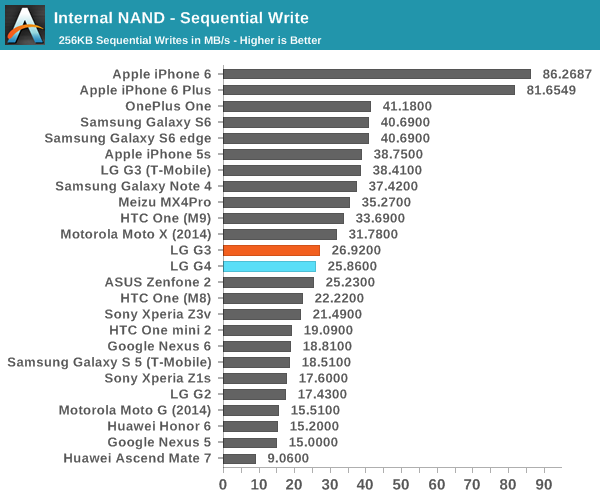
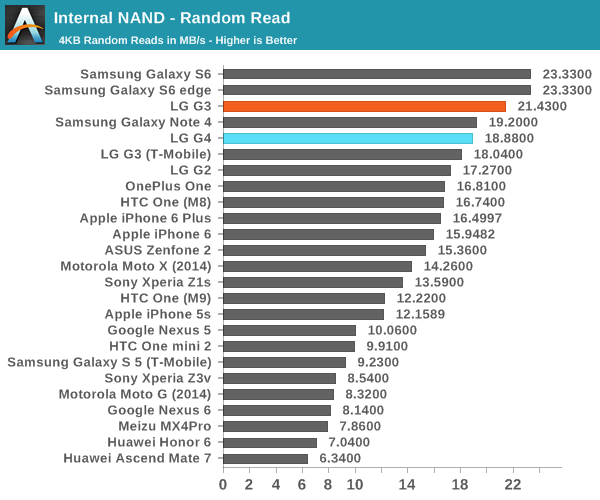
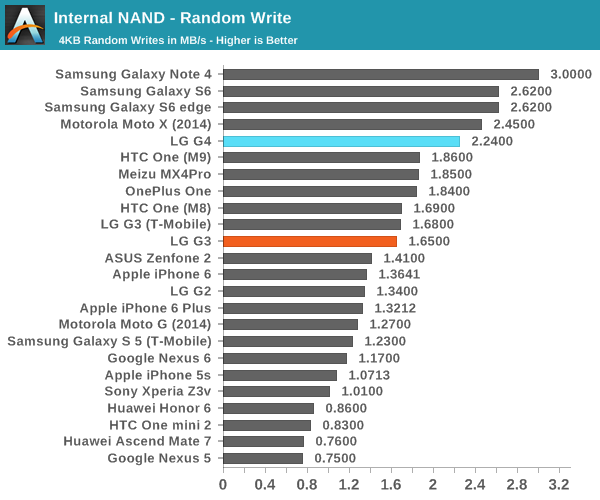
As far as I can tell, the LG G4 has relatively similar NAND performance relative to the G3, but the tuning appears to be somewhat different as the G3 is faster in random reads but the G4 is faster in random writes. Either way, the storage solution in the G4 is sufficient for good performance, although not quite as fast as the Galaxy S6. I suspect that in the absence of an SLC caching system similar to the variant of iPhone 6 that we tested that sequential reads/writes will continue to be relatively low.










84 Comments
View All Comments
Impulses - Friday, July 31, 2015 - link
I get that Anandtech is US centric to an extent, but with a lot of people in the US opting for contract-less plans to save money it might make sense to start factoring price into the equation when it comes to flagships... I wouldn't even have a clue if there are any significant differences, last phone I bought was the N5 and that was the first and only phone I've paid for in full w/o subsidy.tuxRoller - Thursday, July 30, 2015 - link
Such a shame Qualcomm didn't make the 808's cores faster (say, 2GHz) and equip it with at least the adreno 420.I understand why they didn't, and given the 810's design wins, their strategy clearly worked, but it still leads me to wonder "what if".
I wonder what's going on with their implementation of cci(assuming that's the culprit)? They've had enough experience by now to know how to properly implement a standard two tier cache system.
Buk Lau - Thursday, July 30, 2015 - link
if they boosted the 808 to higher clocks, which I'm sure they could since all they've been doing since 801 is just overclocking the chips, that would give OEMs more incentives to choose the 808 over the 810. let's say this, if the 808 comes higher clocked A57s and adreno 420, how many people do you think would even consider the 810? After all the 810 is much more profitable than 808. It just sucks to see how many OEMs got burnt by 810.in a sense, OEMs only have themselves to blame rather than qualcomm for having to release junk phones all over this year. back in the old days qualcomm's SoCs suffered even worse overheating and performance and yet OEMs still persist to use their stuff, simply because they offered an integrated modem
if they didn't spoil qualcomm so much back then, there wouldn't be so little choices in the SoC market with players like Texas instruments and others competing against qualcomm.
Impulses - Friday, July 31, 2015 - link
Don't NVidia and Intel have integrated modems at this point? They're still making SoCs, as is Samsung, seems there's still plenty of choices... We lost what, TI and Sony? I must be forgetting others, I remember lamenting the contracting SoC market too...whiteiphoneproblems - Thursday, July 30, 2015 - link
"It seems that these improvements have been enabled with the use of photoalignment technology, which shares similarities with photolithography but attempts to induce anisotropy in a photoresist analogue on a glass substrate..."Well, you won't see a sentence like that in Gizmodo.com...!
zodiacfml - Friday, July 31, 2015 - link
Another excellent review. Thanks. I also love it when you include many other phones such as the Nexus 5 and Moto G in the benchmarks.Good thing the dual core has real life advantages over the 810. The 8 core spec is nothing but marketing advantage.
As a camera enthusiast, I would also love the manual controls. Yet, I don't think I would use it too often as the control you could get doesn't add to much to the image quality. I mean, using HDR mode pretty much fixes the IQ weaknesses of smartphone cameras to dedicated, larger cameras. The worse noise in the corners probably indicates vignetting with the lenses, only it is fixed/lifted in processing.
Few months after release, the G4 is now slightly cheaper compared to S6 yet I don't think it is enough. The S6 still has a lot better value to G4 because of the display and SoC. The external build quality and video specs makes the S6 even higher. The only fault of the S6 is the small battery they included with it. The Note 5 surely will fix that but it's going to be much more expensive.
Mugur - Friday, July 31, 2015 - link
Nice review, although some phrases were a bit too strange for my taste..."One of the major points of emphasis for us in the smartphone space continues to be display, as even though you can replace a display on a phone, the only real reason to do so is if you shatter the glass cover of the display."
And, of course, I fully disagree with the claim that "the GS6 is roughly equal to or slightly worse than the iPhone 6 Plus as a camera overall". In my personal experience, the S6 camera is the best all-around camera, at least with auto settings and I'm not a Samsung fan...
victorson - Friday, July 31, 2015 - link
Hey Josh! You're fired.neo_1221 - Friday, July 31, 2015 - link
I got a laugh out of that too. :Dmpokwsths - Friday, July 31, 2015 - link
These ridiculous nand/storage benchmarks...